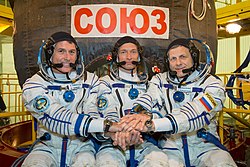Soyuz MS-02
| Mission emblem | |||
|---|---|---|---|

|
|||
| Mission dates | |||
| Mission: | Soyuz MS-02 | ||
| Spacecraft: |
Soyuz 7K-MS ( GRAY index 11F747) serial number 732 |
||
| Launcher: | Soyuz FG (GRAY index 11A511FG) | ||
| Call sign: | Фавор (" Tabor ") | ||
| Crew: | 3 | ||
| Begin: | October 19, 2016, 08:05 UTC | ||
| Starting place: | Baikonur 31/6 | ||
| Space station: | ISS | ||
| Docking place: | Poisk | ||
| Coupling: | October 21, 2016, 09:52 UTC | ||
| Decoupling: | April 10, 2017, 07:57 UTC | ||
| Duration on the ISS : | 170 d, 22 h, 5 min | ||
| Landing: | April 10, 2017, 11:21 UTC | ||
| Landing place: | 147 km SE of Sheqasghan , Kazakhstan 47 ° 22 ′ N , 69 ° 37 ′ E |
||
| Flight duration: | 173 d, 3 h, 16 min | ||
| Earth orbits: | 2694 | ||
| Team photo | |||
 Shane Kimbrough, Sergei Ryschikow and Andrei Borissenko |
|||
| ◄ Before / After ► | |||
|
|||
Soyuz MS-02 is the mission name for a flight of the Russian spacecraft Soyuz to the International Space Station . As part of the ISS program, the flight is designated ISS AF-48S. It was the 48th visit of a Soyuz spacecraft to the ISS and the 154th flight in the Soyuz program.
crew
Main crew
- Sergei Nikolajewitsch Ryschikow (1st space flight), Commander ( Russia / Roskosmos )
- Andrei Iwanowitsch Borissenko (2nd space flight), flight engineer (Russia / Roskosmos)
- Robert Shane Kimbrough (2nd space flight), flight engineer ( USA / NASA )
Substitute team
- Alexander Alexandrowitsch Missurkin (2nd space flight), Commander (Russia / Roscosmos)
- Nikolai Wladimirowitsch Tichonow (1st space flight), flight engineer (Russia / Roscosmos)
- Mark Vande Hei (1st spaceflight), flight engineer (USA / NASA)
Mission description
The mission brought three crew members from ISS expeditions 49 and 50 to the International Space Station.
It was the second use of the further developed Soyuz MS spaceship. This differs from the previous version, among other things, in the new course-NA approach and coupling system. In order to be able to extensively test the new systems, the rendezvous with the ISS lasted two days again instead of the usual six hours.
On September 17, 2016, Roskosmos announced that the start would be postponed due to "technical reasons after tests at the Baikonur Cosmodrome". The cause was a short circuit in the re-entry module of the modernized spaceship. The new start date was October 19, 2016.
The undocking finally took place on April 10, 2017 at 7:57 UTC, and ISS Expedition 51 began on the station with Peggy Whitson as commander. The landing took place on the same day at 11:21 UTC 147 km southeast of Scheskasgan in the Kazakh steppe . When the parachute opened at a height of 10.8 km, a component designed to prevent the lines from twisting hit the landing capsule from the outside and hit a weld seam. This created a crack 3.5 cm in length through which some cabin air escaped. The crew were not in danger because they were wearing spacesuits.
gallery
See also
- List of Soyuz missions
- List of manned missions to the International Space Station
- List of manned space flights
Web links
- Soyuz MS-02 at spacefacts.de
- Soyuz MS-02 on the Russian Space Web
- Soyuz MS-02 in the Encyclopedia Astronautica (English)
- Soyuz MS-02 in the NSSDCA Master Catalog (English)
Individual evidence
- ↑ News 08/11/2011. RSC Energia, August 11, 2011, accessed October 25, 2014 .
- ↑ FliegerRevue April 2014, p. 9, Moderner Soyuz and Progress capsules
- ↑ Derek Richardson: Soyuz MS-02 launch postponed for technical reasons. Spaceflight Insider, September 17, 2016, accessed September 18, 2016 .
- ^ Engineers pin-point location of Electrical Fault on Soyuz MS-02 Spacecraft. Spaceflight101.com, September 25, 2016, accessed April 16, 2017 .
- ↑ Astronomy and Space News - Astro Watch: Soyuz MS-02 Launch Now Targeted for October 19. In: astrowatch.net. September 28, 2016, accessed September 28, 2016 .
- ↑ MKS-50 chronology. kosmonavtika.com, September 10, 2017, accessed October 19, 2017 (French).
- ^ Jeff Foust: Soyuz capsule suffered partial depressurization during April landing. Space News, October 17, 2017, accessed October 19, 2017 .





